In the ever-evolving world of sports, technology has become an indispensable ally. From enhancing athlete performance to transforming the fan experience, Tech EtrueSports stands at the forefront of this revolution. But what exactly is Tech EtrueSports, and why is it so important? Let’s dive into the world where technology and sports converge, creating a dynamic and thrilling landscape.
The Evolution of Technology in Sports
Technology’s impact on sports is not a new phenomenon. From the invention of the stopwatch to the introduction of instant replay, early innovations laid the groundwork for the advanced tech we see today. These initial steps were crucial in shaping the accuracy and fairness in sports.
Technological Milestones in Sports History
Significant milestones include the introduction of video assistant referee (VAR) in football, Hawk-Eye technology in tennis, and the use of biomechanics in athletic training. These advancements have revolutionized how games are played, watched, and analyzed.
Fitness Trackers
Fitness trackers like Fitbit and Garmin have become ubiquitous, providing real-time data on heart rate, steps, and overall activity levels. They offer athletes a detailed understanding of their performance metrics, helping them to optimize their training routines.
Smart Clothing
Smart clothing, embedded with sensors, can monitor various physiological parameters. These garments provide insights into muscle activity, hydration levels, and even stress, enabling athletes to fine-tune their physical conditions.
Wearable Tech for Athletes
For professional athletes, wearable technology extends beyond basic fitness tracking. Devices like GPS trackers, biomechanical sensors, and advanced heart rate monitors provide comprehensive data that can be analyzed to enhance performance and prevent injuries.
Role of Big Data
Big data analytics has transformed sports, providing teams with insights that were previously unimaginable. By analyzing vast amounts of data, teams can develop strategies, scout talents, and even predict the outcomes of games.
Performance Analytics
Performance analytics involves the detailed analysis of an athlete’s movements, strengths, and weaknesses. This data helps in creating personalized training programs and strategies, enhancing the overall performance.
Injury Prevention and Management
Injury prevention is a critical aspect where data analytics plays a vital role. By analyzing patterns and stress points, it’s possible to predict and prevent injuries, ensuring athletes remain in top condition.
VR Training Programs
Virtual reality training programs offer immersive experiences for athletes. From simulating game scenarios to refining techniques, VR provides a safe and controlled environment for training.
AR in Live Sports Viewing
Augmented reality enhances live sports viewing by overlaying additional information, such as player statistics and real-time analysis, onto the live footage. This creates a more engaging and informative viewing experience.
Enhancing Fan Experience
Both VR and AR are used to enhance fan experiences, offering interactive and immersive ways to engage with their favorite sports. This includes virtual stadium tours, interactive replays, and more.
AI for Strategy and Game Planning
AI algorithms analyze vast amounts of data to develop game strategies and plans. By understanding patterns and predicting opponent moves, AI helps teams gain a competitive edge.
Predictive Analytics
Predictive analytics in sports uses historical data to forecast future performances and outcomes. This technology is invaluable for coaches and managers in decision-making processes.
AI in Sports Broadcasting
AI is revolutionizing sports broadcasting by automating highlights, providing real-time analysis, and even offering personalized viewing experiences. AI-powered cameras can follow the action, ensuring every moment is captured perfectly.
Features of Smart Stadiums
Smart stadiums are equipped with cutting-edge technology, including high-speed internet, advanced security systems, and interactive screens. These features create a seamless and enjoyable experience for fans.
Fan Engagement
Smart stadiums offer various ways to engage fans, from mobile apps that provide real-time updates to interactive kiosks. These innovations ensure fans remain connected and engaged throughout the event.
Safety and Security
Advanced security systems, including facial recognition and AI surveillance, ensure the safety of fans and athletes. These technologies help in managing large crowds efficiently and responding to emergencies swiftly.
Rise of E-Sports
E-Sports has grown exponentially, becoming a multi-billion-dollar industry. Competitive gaming attracts millions of viewers worldwide, and the technology driving these events is constantly evolving.
Technology in Gaming Competitions
High-performance gaming rigs, advanced graphics, and real-time streaming technologies are crucial for gaming competitions. These innovations ensure smooth gameplay and immersive experiences for both players and viewers.
Future of E-Sports
The future of E-Sports looks promising, with advancements in VR and AI set to revolutionize the gaming experience. As technology continues to evolve, the boundaries of E-Sports will expand, attracting even larger audiences.
Advances in Sports Gear
Innovations in sports gear, such as lightweight materials and aerodynamic designs, have significantly impacted performance. These advancements help athletes achieve new heights in their respective sports.
Smart Equipment
Smart sports equipment, embedded with sensors, provides real-time data on performance. From smart tennis rackets to connected basketballs, these tools offer valuable insights for improvement.
Impact on Performance
The impact of technology on sports equipment is profound, enhancing precision, efficiency, and safety. Athletes can now push their limits while minimizing the risk of injury.
Evolution of Sports Broadcasting
Sports broadcasting has evolved from radio commentaries to high-definition live streams. Technological advancements have made it possible to deliver high-quality content to a global audience.
Role of Social Media
Social media platforms have become essential for sports broadcasting, offering real-time updates, live interactions, and behind-the-scenes content. They provide a direct link between teams, athletes, and fans.
Live Streaming and OTT Platforms
Over-the-top (OTT) platforms have revolutionized how sports are consumed. Services like ESPN+, DAZN, and Twitch offer live streaming of sports events, making it accessible to a wider audience.
Sports Apps for Fans
Sports apps provide fans with real-time scores, news updates, and interactive features. These apps enhance the fan experience by keeping them connected and informed.
Training and Fitness Apps
Training and fitness apps offer personalized workout plans, tracking progress, and providing motivation. They are an excellent resource for both amateur and professional athletes.
Real-Time Updates and Engagement
Mobile applications ensure that fans and athletes receive real-time updates, from game scores to injury reports. These apps facilitate constant engagement and interaction.
Technology in Sports Medicine
Advancements in sports medicine technology have improved diagnosis, treatment, and rehabilitation processes. Technologies like MRI, ultrasound, and 3D imaging play a crucial role in athlete care.
Rehab Tech for Athletes
Rehabilitation technology, including electrotherapy, hydrotherapy, and robotic rehabilitation, helps athletes recover faster and more efficiently. These tools are essential for a quick and safe return to sports.
Monitoring and Recovery
Continuous monitoring of athletes’ health using wearable devices ensures optimal recovery. These technologies track recovery progress and help in making necessary adjustments to training and rehabilitation plans.
Privacy Concerns
With the extensive use of technology comes the risk of privacy invasion. It’s essential to handle athletes’ data responsibly to maintain their privacy and trust.
Data Security
Ensuring data security is crucial in the tech-driven sports industry. Measures need to be in place to protect sensitive information from breaches and cyber threats.
Fair Play and Technology
The use of technology in sports must be balanced to ensure fair play. Over-reliance on technology could potentially undermine the spirit of the game, making it essential to establish clear guidelines.
Emerging Technologies
Emerging technologies like 5G, blockchain, and quantum computing hold the potential to revolutionize sports further. These innovations promise to enhance every aspect of the sports industry.
Predictions for the Next Decade
The next decade will likely see increased integration of AI, VR, and wearable technology in sports. These advancements will continue to push the boundaries of what’s possible, creating new opportunities and challenges.
Long-Term Impact on Sports
The long-term impact of technology on sports is profound, with the potential to transform every facet of the industry. From training and performance to fan engagement and broadcasting, the future of sports looks exciting and dynamic.
Conclusion
Technology and sports have formed a symbiotic relationship, each driving the other to new heights. As we look to the future, it’s clear that Tech EtrueSports will continue to play a pivotal role in shaping the sports landscape. Whether you’re an athlete, a coach, or a fan, the advancements in technology promise to make sports more thrilling, engaging, and accessible than ever before.
FAQs
What is Tech EtrueSports?
Tech EtrueSports refers to the integration of advanced technologies in the sports industry, enhancing various aspects such as athlete performance, fan engagement, and sports broadcasting.
How is wearable technology used in sports?
Wearable technology is used to monitor and analyze athletes’ performance, track fitness metrics, prevent injuries, and enhance training programs.
What are smart stadiums?
Smart stadiums are venues equipped with advanced technologies, including high-speed internet, interactive screens, and AI-driven security systems, to enhance the fan experience and ensure safety.
How does AI impact sports broadcasting?
AI impacts sports broadcasting by automating highlight reels, providing real-time analysis, and offering personalized viewing experiences through advanced camera and data processing technologies.
What is the future of tech etruesports?
The future of e-sports looks promising with advancements in VR, AI, and streaming technologies, which will enhance gameplay, attract larger audiences, and expand the scope of competitive gaming.










